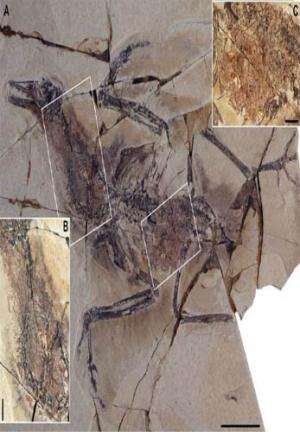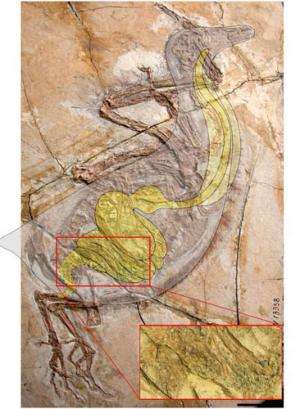Fig.1 Yanornis preserving whole fish in the crop and macerated fish bones in the ventriculus: (A) full slab, scale bar equals five cm; (B) detail of the crop, scale bar equals one cm; (C) detail of the ventriculus, scale bar equals one mm. Credit: Jingmai O’Connor
In a recent paper describing ten new specimens of Yanornis martini identified by the director of the Shandong Tianyu Museum of Natural History Mr. Xiaoting Zheng, an international team of scientists lead by Dr. Jingmai O'Connor of the Institute of Vertebrate Palaeontology and Paleoanthropology (IVPP), Chinese Academy of Sciences, reveal that the digestive system of the ancestors to modern birds was essentially modern in all aspects. The study was published April 14 in PLOS ONE.
Compared to other groups of vertebrates, the digestive system of living birds is unique and highly modified. Compared to mammals the digestive system is proportionately shorter; the oesophagus (throat) is large and flexible with an accessory organ called the crop and two stomachs are present. These specializations are inferred to have evolved in order to produce a highly efficient digestive system capable of meeting the metabolic demands of powered flight within the physical constraints of aerial locomotion, which requires the system to be lightweight.
With the description of these new specimens, Yanornis is the best known Early Cretaceous ornithuromorph bird (a basal member of the clade that also includes living birds). A total of thirteen specimens have been published, nearly all of which preserve typically rare direct indicators of diet. Although previously thought to have seasonally switched diet similar to some living birds, these new specimens reveal that Yanornis was an entirely piscivorous bird and thus morphology and diet are now no longer contradictory, as previously inferred.
Fig.2 Interpretative drawing of the alimentary canal of Yanornis superimposed over a specimen. Scale bar equals 1 cm. Credit: Jingmai O’Connor
Yanornis had an expandable crop capable of containing more than one whole fish. Despite the presence of numerous sharp and recurved teeth, Yanornis did not chew its food before swallowing, the same as living fish eating birds, which of course are toothless. This indicates that the teeth of Yanornis evolved to be used in prey capture. Also like living birds, the gizzard of Yanornis did not require gizzard stones to break up the fish and the hard to digest items like bones were regurgitated in pellets. This reveals that the complex system of muscle contractions responsible for moving food from each section of the digestive system, capable of working in both directions, had already evolved in Early Cretaceous ornithuromorph birds. This muscular system makes the digestive system of birds highly efficient by allowing items that would take long periods of time to digest to be regurgitated, reducing the weight of digestive system as it processes food.
The gastroliths (stones) in one specimen of Yanornis are reinterpreted as in the intestines, not the gizzard, consistent with differences in the size of the stones and their position compared to other specimens preserving true geo-gastrolith gizzard stones. This is the first fossilized case of intestinal impaction. This disorder occurs relatively commonly in a number of different types of living birds with different diets. The team of researchers hypothesize that stones were accidently eaten along with fish while Yanornis was feeding on the lakeshore. The high amount of volcanic activity at the time of the deposition of the Jehol would have disturbed the pH of the lake causing mass fish mortalities and large amounts of food opportunistically available for scavenging.
This study highlights the difficulty in interpreting diet in extinct taxa, even with direct evidence. Based on only two specimens, diet could not be correctly inferred. However, because preserved indicators of diet are typically so rare, inferences of diet are usually based on a single specimen for most species, and potentially may be inaccurate. "These fossils provide incredible insight into the digestive system of early birds," says corresponding author of the study Dr. Jingmai O'Connor of the IVPP. "It is incredible to see that the earliest ancestors to modern birds already had such an advanced alimentary canal in the Early Cretaceous."
One co-author of the study, Dr. Fritz Huchzermeyer of the University of Pretoria (South Africa), succumbed to cancer of the liver shortly before acceptance of this publication. This wonderful scientist was an endless source of information on living archosaurs gleaned from his decades of hands on research on crocodiles and birds, which are the subjects of numerous books on the biology and in particular diseases of these animals. He had an endless thirst for knowledge and continued his research right up until his passing. He will be sorely missed by the scientific community.
More information: Zheng X, O'Connor JK, Huchzermeyer F, Wang X, Wang Y, et al. (2014) "New Specimens of Yanornis Indicate a Piscivorous Diet and Modern Alimentary Canal." PLoS ONE 9(4): e95036. DOI: 10.1371/journal.pone.0095036
Journal information: PLoS ONE
Provided by Chinese Academy of Sciences

























